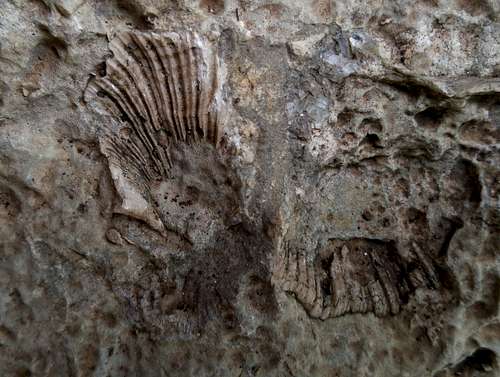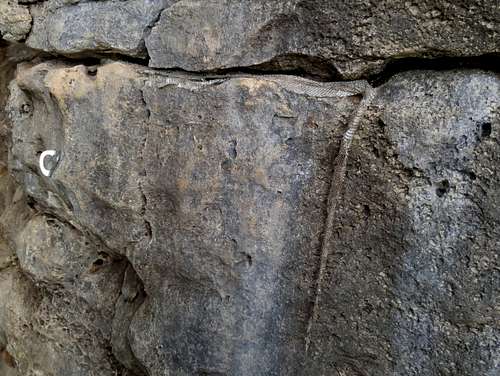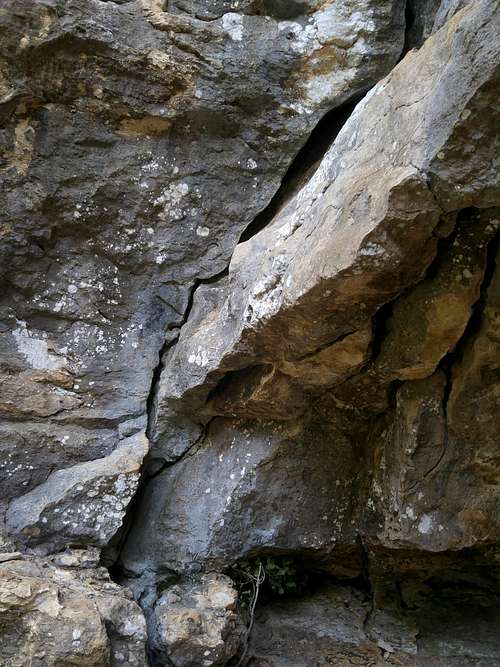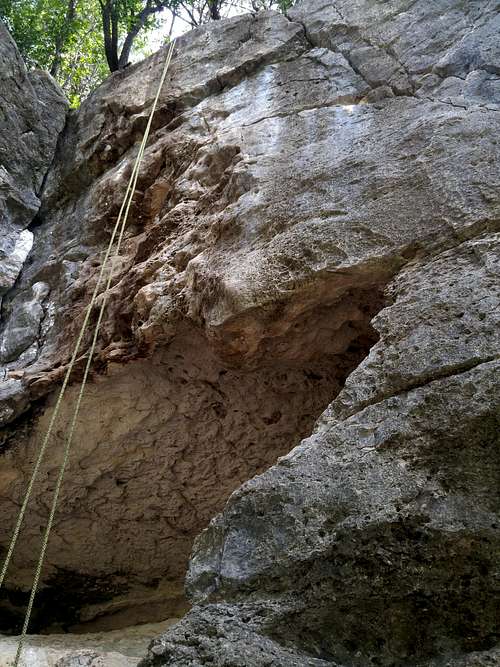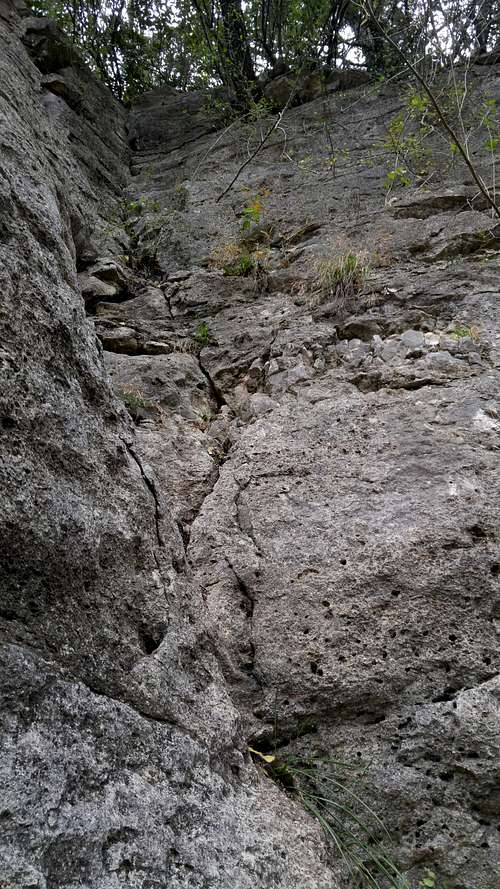-
 4812 Hits
4812 Hits
-
 75.81% Score
75.81% Score
-
 6 Votes
6 Votes
|
|
Mountain/Rock |
|---|---|
|
|
30.24510°N / 97.7979°W |
|
|
Trad Climbing, Sport Climbing, Toprope |
|
|
Spring, Summer, Fall, Winter |
|
|
Overview
5.8 Sanctuary is one of several climbing locations within the Barton Creek Greenbelt, a strip of nature just minutes from downtown Austin that is a popular area for hiking, climbing, mountain biking, swimming, and kayaking/tubing (when water levels are high enough, which is not often). Although it is a five-minute walk from Seismic Wall, it does not seem to get much use.
From the name, you would guess that this crag has a ton of moderates, especially of the namesake grade. Wrong. Actually, it has just five routes, and one is not, in my opinion, worth doing except as a scramble to go up and set a toprope for the other routes.
Of the three routes that are worth doing, one is a 5.8, the second is a 5.9+, and the third is a 5.8+ (this is in accordance with the local guidebook; some other websites rate each one slightly lower). There is a 5.10c as well, though it is really a variation of the 5.9. So maybe the name comes from two of the three main routes being 5.8 and from the fact that it is only a quarter-mile away from a very popular crag yet sees light traffic by comparison.
Why does it see light traffic? I don't know for sure, but my guess is that the bigger crag with more routes is closer, that there is only one bolted route, and that in an area where bolted routes are the norm a lot of people either do not know how to build toprope anchors or do not have the gear to do so.
This small crag has several things going for it, though:
- Easy access to the top means it is easy to set a toprope anchor. Some TR the 5.8 and the 5.8+ off the 5.9's anchors, but that is setting up a bad swing if you fall. Either use directionals or just make an appropriate TR anchor above the route of choice.
- As already mentioned, comparatively light usage.
- The lighter usage means that the rock is not as polished as it is at Seismic Wall. Actually, the rock here is very good.
- Some of the routes can be led on gear. That's not too common in the Greenbelt.
Getting to this crag means crossing Barton Creek. Sometimes Barton Creek is completely dry here. Other times, there is water but fording the creek is easy. Occasionally, though, the water gets high enough to turn Barton Creek into a Class III/IV whitewater run. Before going, check water levels here. Since the watercourse is considered runnable from 250 to 3500 cfs, I recommend crossing only when it is below 250. Besides, when the creek is high enough to run, the bases of the climbs might be underwater. At around 100, I have found waist-deep spots where the current is light but you obviously had better have your phone, wallet, key fob, and gear protected.
Getting There
There are several access points for the Barton Creek Greenbelt, and you could hike or bike to 5.8 Sanctuary from any of them. This page covers the closest trailhead. From the parking lot, it takes me less than 10 minutes to reach the crag.
From whatever point of origin, get onto 360. If you're headed south, look for a stoplight shortly after the bridge over Barton Creek. If you're headed north, the stoplight is before the bridge.
At this light, turn into a business park. (Northbound travelers who miss this turn can turn in onto another road very shortly thereafter.)
Once in the business park, turn left at the first opportunity and drive to a signed gravel road denoting the Barton Creek Greenbelt. Park, take the main trail down to the creek, and cross over to Seismic Wall. You'd have to be blind to miss it.
Then walk along the trail past the right end of Seismic Wall. After about 5 minutes, notice a faint trail leading slightly uphill to a cave-like feature. That's the base of the crag. Before that, you will probably see a well-worn trail branching off to the left. That trail will get you to the top of the crag if you want to set a toprope.
I have updated names and grades to match the new edition of Austin Climbing: Sport Routes & Deep Water Solos by John Hogge, who has been heavily involved in route development in the Austin area. Thus, some of this information will differ from what is on other websites.
From left to right as you face the crag:
- Fist Crack, 5.8-- This is the obvious crack system on the left. I have toproped this and led it on gear (medium and large hexes and cams). Be aware that the crack can be dirty-- get ready to have dirt in your eyes and to be spitting dirt from your mouth. When finishing the route, you have three options if leading it: you can traverse right to the Face Off anchors, which is said to be a solid 5.9; you can top out using the tree above the edge as a hold, maybe knocking this down to 5.7+ or 5.8-; or you can top out without using the tree, which I think keeps it 5.8. The first time I led it, pride made me forgo the tree; the second time, I grabbed the tree and slung it as well. This route is a 5.7 in other sources; personally, I do not think it is 5.8 (the slightly overhanging finish perhaps is 5.8), but I have adjusted in keeping with the guidebook.
- Face On, 5.10c-- Use the harder holds to the left of Face Off.
- Face Off, 5.9+-- The only bolted route here. 2 bolts to the anchors. The crux is the very physical move from the start to above the cave, but it's also pretty thin for a little bit after the second bolt, and the anchor clip isn't easy either since the anchor is just chains. As of February 2017, I have climbed this route four times. The first time, I got it clean. The second time, I could not remember or figure out the start and had a terrible time. The third and fourth times, I remembered the positions and had it dialed, though it still wasn't easy. Some who climb this say they have climbed many an easier 5.10 due to the burly start on this one.
- Swordfish, 5.8+-- Gain the face to the right of Face Off and then follow the finger cracks. This one can go on small gear, but the cracks are pretty shallow and irregular and the rock seems brittle. This one is awkward on toprope because of the diagonal aspect and the swing potential.
- Pointless Wonder, 5.4-- This one is around the corner from the others. A larger crack is just left of it, and that crack is a Class 4 scramble. Pointless Wonder (which I think is much easier than 5.4) will take stoppers. It is easy to climb and makes a great spot to learn how to place passive gear.
- Unnamed Crack, 5.6-- Just right of Pointless Wonder. This is not a route for a new trad leader, as it is on sketchy limestone. It's not really a route for anyone except a trad climber desperate to place gear in an area swarming with bolts. The rock is weak, some of the placements are questionable, and the top-out and belay are a mess. The finish is brushy and dirty, and then you have to fight through brush to set up a belay off trees. Lots of fun. Fortunately, you can lower your second and then crash through a little more brush to reach a trail that takes you back down. Although my two ascents in the spring of 2018 were then the only two lead ascents of which I knew, I'm not claiming an FA on this because someone had probably at least free soloed it already. But if I ever find out I did do the FA, then I might name it "Really Pointless Wonder."
The climbs are about 30'.
As of the submission date of this page, I have not been in the area very long, but I understand that there is disagreement about trad in the Greenbelt, with some saying the rock is too brittle and others saying there are trad-friendly routes if you take care. Fist Crack has deep, solid features that seem friendly to pro. Swordfish can go on gear as well (small and medium stoppers). Pointless Wonder can take gear, too. If in doubt, do an all-passive lead, as a cam is more likely to skate out of or blow up the rock out here than a stopper or hex is.


